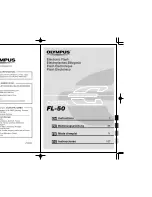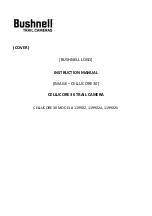
109
ķ
according to the chosen setting (see 7.6). There is no flash range indi-
cation in remote mode or when the main reflector is swivelled or til-
ted.
16.1 Automatic adjustment of the flash range indication
Group B, C, D and E cameras transmit to the flash unit the flash parameters
for ISO film speed, focal length of the lens (mm), aperture and exposure cor-
rection. The flash unit automatically adjusts its settings accordingly. The
maximum flash range is calculated from the flash parameters and the guide
number and indicated on the display.
This requires an exchange of data between camera and flash unit, effected
for example by tapping the shutter release.
Automatic adjustment of the maximum flash range display requires that the
camera be equipped with a suitable CPU lens (see 6).
16.2 Manual adjustment of the flash range indication
If the flash unit is used with a Group A camera, then zoom position, ISO film
speed and f-stop parameters must be adjusted manually on the flash unit if
the flash range indication is to be reliable (see Chapter 6).
16.3 Exceeding the display range
The flash unit can indicate maximum flash ranges of up to 199 m or 199 ft.
This display range can be exceeded in the case of high ISO values (e.g., ISO
6400) and large aperture openings. An arrow or triangle after the distance
value indicates that the display range has been exceeded.
16.4 „FEE“ error indication on the flash unit’s LC display
On some cameras and in some camera modes (for example, program „P“,
vari-programs, „S“ shutter priority mode), it is necessary to set the aperture
ring of the lens to the maximum f-number. Otherwise the error message
„FEE“ will appear on the LC display of the flash unit or camera. If this occurs,
check the settings on the camera or the lens (see the camera’s operating
instructions).
16. 5 Guide number indication when using lenses without CPU
Lenses without CPU (i.e., without electronic data transmission) do not transmit
information about focal length or the aperture setting to the camera. If such a
lens is used with a Group B, C, D or E camera, then the flash unit will receive
only ISO data from the camera. The position of the main reflector must be
adjusted manually (see 6.3).
With some cameras the flash unit’s LC display will, in this case, show the gui-
de number for the current setting instead of the distance. The maximum flash
range is derived from the equation:
guide number
Maximum flash range = —————————
aperture
Guide numbers are not displayed when the main reflector is tilted down.
17. Flash exposure memory
Some Group E cameras (see Table 1) have flash exposure memory (FV
memory). This is supported by the flash unit in i-TTL flash mode. It can be
used to define and store the exposure level for the subsequent shot before the
shot is actually taken. This can be useful when, for example, the flash expo-
sure has to be adjusted to specific details that may not necessarily be identi-
cal with the main subject.
This function is activated on the camera, in some instances as an individual
function. The subject detail to which the flash exposure is to be adjusted is
sighted and brought into focus with the AF sensor/metering window in the
camera. When the AE-L/AF-L button (the terminology may vary with the
camera model) on the camera is pressed, the flash unit fires a test flash. The
stored metering value (e.g., „EL“) is then displayed in the camera viewfinder.
The camera uses the reflected light of the test flash to determine the light out-
put required for the subsequent exposure. The actual main subject can then
be brought into focus with the camera’s AF sensor/metering window. When
the shutter release is pressed, the picture will be exposed with the previously
defined light output of the flash unit.
☞
706 47 0029-A3 58 AF-1 N 30.05.2007 8:05 Uhr Seite 109
















































